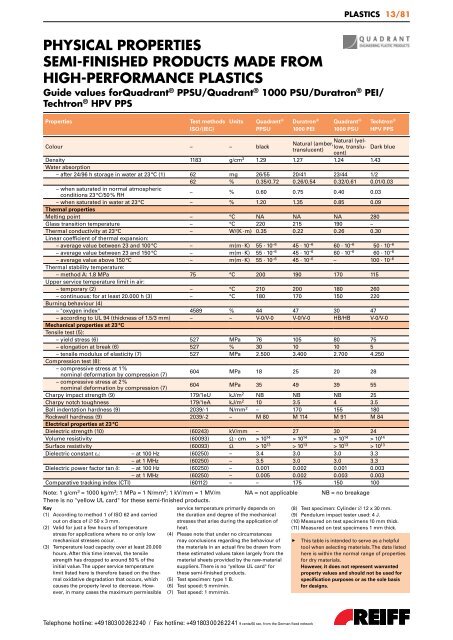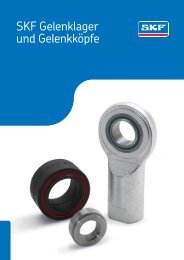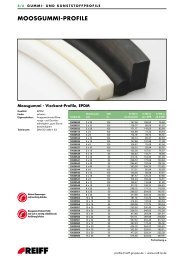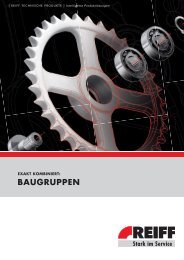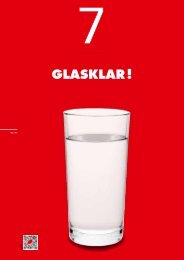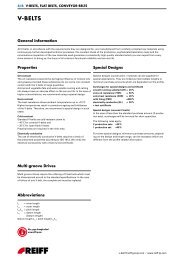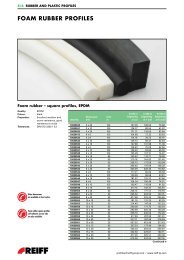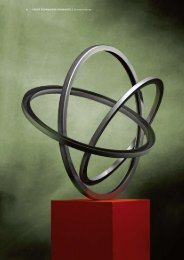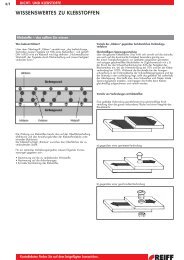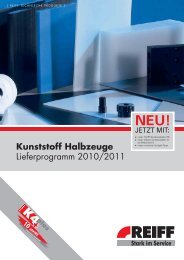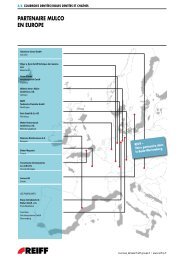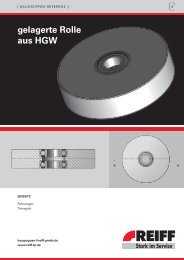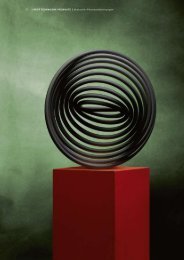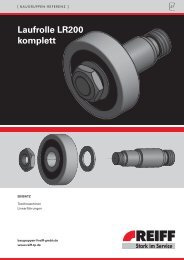REGISTER OVERVIEW PLASTICS
REGISTER OVERVIEW PLASTICS
REGISTER OVERVIEW PLASTICS
You also want an ePaper? Increase the reach of your titles
YUMPU automatically turns print PDFs into web optimized ePapers that Google loves.
Telephone hotline: +49 1803 00 26 22 40 / Fax hotline: +49 1803 00 26 22 41 9 cents/60 sec. from the German fixed network<br />
<strong>PLASTICS</strong> 13/81<br />
PHYSICAL PROPERTIES<br />
SEMI-FINISHED PRODUCTS MADE FROM<br />
HIGH-PERFORMANCE <strong>PLASTICS</strong><br />
Guide values forQuadrant ® PPSU/Quadrant ® 1000 PSU/Duratron ® PEI/<br />
Techtron ® HPV PPS<br />
Properties Test methods Units Quadrant ® Duratron ® Quadrant ® Techtron ®<br />
ISO/(IEC) PPSU 1000 PEI 1000 PSU HPV PPS<br />
Colour – – black<br />
Natural (yel-<br />
Natural (amber,<br />
low,translu- translucent)<br />
cent)<br />
Dark blue<br />
Density 1183 g/cm3 Water absorption<br />
1.29 1.27 1.24 1.43<br />
– after 24/96 h storage in water at 23 °C (1) 62 mg 26/55 20/41 23/44 1/2<br />
62 % 0.35/0.72 0.26/0.54 0.32/0.61 0.01/0.03<br />
– when saturated in normal atmospheric<br />
conditions 23 °C/50 % RH<br />
– % 0.60 0.75 0.40 0.03<br />
– when saturated in water at 23 °C<br />
Thermal properties<br />
– % 1.20 1.35 0.85 0.09<br />
Melting point – °C NA NA NA 280<br />
Glass transition temperature – °C 220 215 190 –<br />
Thermal conductivity at 23 °C<br />
Linear coefficient of thermal expansion:<br />
– W/(K · m) 0.35 0.22 0.26 0.30<br />
– average value between 23 and 100 °C – m(m · K) 55 · 10 –6 45 · 10 –6 60 · 10 –6 50 · 10 –6<br />
– average value between 23 and 150 °C – m(m · K) 55 · 10 –6 45 · 10 –6 60 · 10 –6 60 · 10 –6<br />
– average value above 150 °C – m(m · K) 55 · 10 –6 45 · 10 –6 – 100 · 10 –6<br />
Thermal stability temperature:<br />
– method A: 1.8 MPa<br />
Upper service temperature limit in air:<br />
75 °C 200 190 170 115<br />
– temporary (2) – °C 210 200 180 260<br />
– continuous: for at least 20.000 h (3)<br />
Burning behaviour (4)<br />
– °C 180 170 150 220<br />
– "oxygen index" 4589 % 44 47 30 47<br />
– according to UL 94 (thickness of 1.5/3 mm)<br />
Mechanical properties at 23 °C<br />
Tensile test (5):<br />
– – V-0/V-0 V-0/V-0 HB/HB V-0/V-0<br />
– yield stress (6) 527 MPa 76 105 80 75<br />
– elongation at break (6) 527 % 30 10 10 5<br />
– tensile modulus of elasticity (7)<br />
Compression test (8):<br />
527 MPa 2.500 3.400 2.700 4.250<br />
– compressive stress at 1 %<br />
nominal deformation by compression (7)<br />
604 MPa 18 25 20 28<br />
– compressive stress at 2 %<br />
nominal deformation by compression (7)<br />
604 MPa 35 49 39 55<br />
Charpy impact strength (9) 179/1eU kJ/m2 NB NB NB 25<br />
Charpy notch toughness 179/1eA kJ/m2 10 3.5 4 3.5<br />
Ball indentation hardness (9) 2039/-1 N/mm2 – 170 155 180<br />
Rockwell hardness (9)<br />
Electrical properties at 23 °C<br />
2039/-2 – M 80 M 114 M 91 M 84<br />
Dielectric strength (10) (60243) kV/mm – 27 30 24<br />
Volume resistivity (60093) Ω · cm > 1014 > 1014 > 1014 > 1014 Surface resistivity (60093) Ω > 1013 > 1013 > 1013 > 1013 Dielectric constant εr: – at 100 Hz (60250) – 3.4 3.0 3.0 3.3<br />
– at 1 MHz (60250) – 3.5 3.0 3.0 3.3<br />
Dielectric power factor tan δ: – at 100 Hz (60250) – 0.001 0.002 0.001 0.003<br />
– at 1 MHz (60250) – 0.005 0.002 0.003 0.003<br />
Comparative tracking index (CTI) (60112) – – 175 150 100<br />
Note: 1 g/cm3 = 1000 kg/m3 ; 1 MPa = 1 N/mm2 ; 1 kV/mm = 1 MV/m NA = not applicable NB = no breakage<br />
There is no "yellow UL card" for these semi-finished products.<br />
Key<br />
service temperature primarily depends on (8) Test specimen: Cylinder ∅ 12 x 30 mm.<br />
(1) According to method 1 of ISO 62 and carried the duration and degree of the mechanical (9) Pendulum impact tester used: 4 J.<br />
out on discs of ∅ 50 x 3 mm.<br />
stresses that arise during the application of (10) Measured on test specimens 10 mm thick.<br />
(2) Valid for just a few hours of temperature<br />
heat.<br />
(11) Measured on test specimens 1 mm thick.<br />
stress for applications where no or only low (4) Please note that under no circumstances<br />
mechanical stresses occur.<br />
may conclusions regarding the behaviour of � This table is intended to serve as a helpful<br />
(3) Temperature load capacity over at least 20.000 the materials in an actual fire be drawn from tool when selecting materials. The data listed<br />
hours. After this time interval, the tensile<br />
these estimated values taken largely from the here is within the normal range of properties<br />
strength has dropped to around 50 % of the material sheets provided by the raw-material for dry materials.<br />
initial value. The upper service temperature suppliers. There is no "yellow UL card" for<br />
However, it does not represent warranted<br />
limit listed here is therefore based on the ther- these semi-finished products.<br />
property values and should not be used for<br />
mal oxidative degradation that occurs, which (5) Test specimen: type 1 B.<br />
specification purposes or as the sole basis<br />
causes the property level to decrease. How- (6) Test speed: 5 mm/min.<br />
for designs.<br />
ever, in many cases the maximum permissible (7) Test speed: 1 mm/min.


